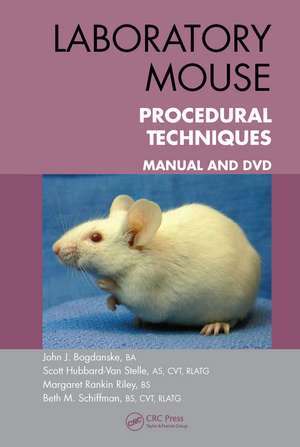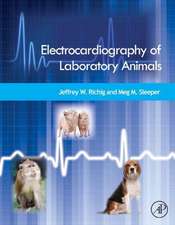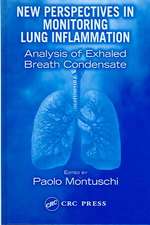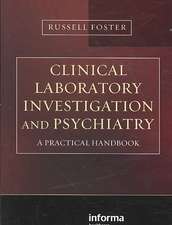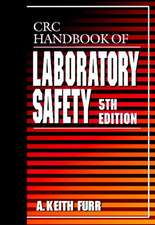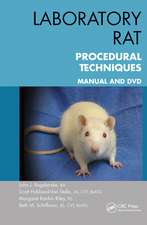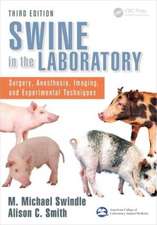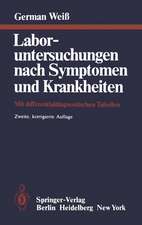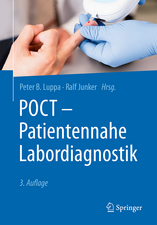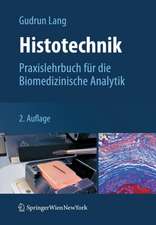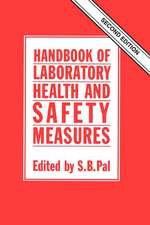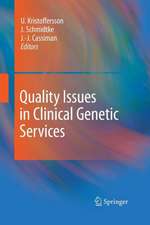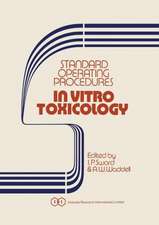Laboratory Mouse Procedural Techniques: Manual and DVD
Autor John J. Bogdanske, Scott Hubbard-Van Stelle, Margaret Rankin Riley, Beth Schiffmanen Limba Engleză Paperback – 19 noi 2010
Preț: 319.60 lei
Preț vechi: 414.34 lei
-23% Nou
Puncte Express: 479
Preț estimativ în valută:
61.15€ • 64.02$ • 50.60£
61.15€ • 64.02$ • 50.60£
Carte tipărită la comandă
Livrare economică 05-19 aprilie
Preluare comenzi: 021 569.72.76
Specificații
ISBN-13: 9781439850428
ISBN-10: 1439850429
Pagini: 100
Ilustrații: 56 color images
Dimensiuni: 156 x 234 x 8 mm
Greutate: 0.21 kg
Ediția:New.
Editura: CRC Press
Colecția CRC Press
ISBN-10: 1439850429
Pagini: 100
Ilustrații: 56 color images
Dimensiuni: 156 x 234 x 8 mm
Greutate: 0.21 kg
Ediția:New.
Editura: CRC Press
Colecția CRC Press
Public țintă
Veterinary/lab animal technicians and other animal caretakers, biomedical and toxicological researchers/laboratory veterinarians social & behavioral scientists working with rodents.Cuprins
DVD: Mouse Handling/Transfer. Mouse Restraint. Oral Gavage. One-Handed Injection Technique. Intraperitoneal Injection (IP): One person. Intraperitoneal Injection (IP): One-Person Towel Method. Subcutaneous Injection (SQ). Subcutaneous Injection (SQ): One-Person Towel Method. Maxillary Bleed. Pedal Vein Blood Draw. Saphenous Vein Blood Draw. Tail Vein Injection. Retro-Orbital Bleed: Anesthesia Required. Retro-Orbital Injections: Anesthesia Required. Ear Notching. Ear Tagging.
Mouse Procedural Technique Manual & Handouts: Intraperitoneal Injection (IP). Subcutaneous Injection (SQ). Maxillary Bleed. Oral Gavage. Pedal Vein Blood Draw. Saphenous Vein Blood Draw. Retro-orbital Blood Draw. Retro-orbital Injection. Tail Vein Injection. Ear Notch/Punch & Ear Tags. The Mouse (Mus musculus) Class Outline. Normative Data. Appendix: Blood Volume.
Mouse Procedural Technique Manual & Handouts: Intraperitoneal Injection (IP). Subcutaneous Injection (SQ). Maxillary Bleed. Oral Gavage. Pedal Vein Blood Draw. Saphenous Vein Blood Draw. Retro-orbital Blood Draw. Retro-orbital Injection. Tail Vein Injection. Ear Notch/Punch & Ear Tags. The Mouse (Mus musculus) Class Outline. Normative Data. Appendix: Blood Volume.
Recenzii
The texts, Laboratory Rat and Laboratory Mouse Procedural Techniques Manual and DVD are short, easily read/watched manuals that review the very basic handling for the animal care technician through the clear use of discussion and accompanying photographs, enhanced with a clear, understandable DVD demonstrating each procedure discussed. Not only is the safety of the laboratory specimen of concern, but even more importantly, the safety of the human laboratory technicians and researchers. The reader is assumed to have fundamental laboratory rodent training in place. This is not meant as a primary training tool but to review and refresh existing understanding. Each of the texts is similar in organization and content which conveniently aids in navigation of topics.
—Sandra L. Jex, DVM, ALN Magazine
"The videography is professional, and the procedures are explained and demonstrated in a slow, consistent manner. By no means is this a complete compendium of procedural techniques for mice; however, this manual and DVD are reasonably priced and appropriately targeted to novices or those who occasionally work with mice"
—Katherine Wasson, DVM, PhD, DACLAM, in JAVMA
"Currently, there is a paucity of training material for experimental techniques in laboratory rodents, particularly audiovisual material. The manuals and accompanying DVDs will be of great interest to students, technicians, veterinarians, and investigators. Importantly, the straightforward approach taken in both the printed manual and DVD will be seen as an excellent tool for non-English speaking personnel."
—Mark A. Suckow, DVM, Dipl. ACLAM, Director, Freimann Life Science Center, University of Notre Dame, Past President of AALAS
"Persons (students of animal technology) can watch these videos to get the picture and then practice with an experienced individual. It is a good refinement step of the 3Rs….I will be very excited to have these manuals to use as training items with my students and as reference resources in our animal facility."
—Bruce W. Kennedy, MS, RLATG, CMAR, Compliance Associate, Research & Graduate Studies, California State Polytechnic University, Pomona, Past President of AALAS
—Sandra L. Jex, DVM, ALN Magazine
"The videography is professional, and the procedures are explained and demonstrated in a slow, consistent manner. By no means is this a complete compendium of procedural techniques for mice; however, this manual and DVD are reasonably priced and appropriately targeted to novices or those who occasionally work with mice"
—Katherine Wasson, DVM, PhD, DACLAM, in JAVMA
"Currently, there is a paucity of training material for experimental techniques in laboratory rodents, particularly audiovisual material. The manuals and accompanying DVDs will be of great interest to students, technicians, veterinarians, and investigators. Importantly, the straightforward approach taken in both the printed manual and DVD will be seen as an excellent tool for non-English speaking personnel."
—Mark A. Suckow, DVM, Dipl. ACLAM, Director, Freimann Life Science Center, University of Notre Dame, Past President of AALAS
"Persons (students of animal technology) can watch these videos to get the picture and then practice with an experienced individual. It is a good refinement step of the 3Rs….I will be very excited to have these manuals to use as training items with my students and as reference resources in our animal facility."
—Bruce W. Kennedy, MS, RLATG, CMAR, Compliance Associate, Research & Graduate Studies, California State Polytechnic University, Pomona, Past President of AALAS
Notă biografică
John BogdanskeAfter graduating from Augustana College, John started his research career in 1986 at the University of Wisconsin-Madison, Department of Nutritional Sciences working with dietary fiber and the nutritional value of common foods. In 1991 he moved to the School of Veterinary Medicine on the Madison campus to take the position of Lab Manager in the Comparative Orthopaedic Research Laboratory (CORL), Department of Medical Sciences. The CORL's mission was to investigate fundamental orthopaedic problems that affected either animals or humans in order to identify the mechanisms that cause disease or to develop treatments that would enhance the lives of individuals affected with these diseases. In 2004 he joined the Research Animal Resources Center (RARC) as a Training Coordinator. Along with Scott, Margaret and Beth, he helps develop, manage, and present a comprehensive training program to all UW-Madison research animal users and related staff. John is an active member of Laboratory Animal Welfare Training Exchange (LAWTE) and the American Association for Laboratory Animal Science (AALAS). John spends most of his free time with his family usually playing in the outdoors (on a bike).Scott Hubbard-Van StelleScott attended the University of Wisconsin in the pre-veterinary program before getting his degree as a certified veterinary technician from the Madison Area Technical College. He worked in a veterinary hospital for a small animal practitioner as a surgical nurse, followed by working for Raltech (now Covance) as a sample collection specialist. Scott started his career at the University of Wisconsin in 1980 when he took a position as a Veterinary Technician in the Veterinary Science Department (currently the department of Animal Health and Biomedical Sciences). After several years, he was promoted to Sr. Research Specialist. During his 19 years with the department, Scott set up the teachin
Descriere
This combination manual and DVD provides much-needed training on the proper handling of mice used in biomedical research. The DVD includes narrated video clips that demonstrate and describe each procedural technique. The manual contains handouts with color illustrations and descriptive text for each technique, including the purpose and application of the procedure, recommended skills, and necessary supplies. The pair can be used as a training resource and refresher for lab animal veterinarians, veterinary technicians, animal care staff, trainers, and research investigators and staff who work with mice and rats.
